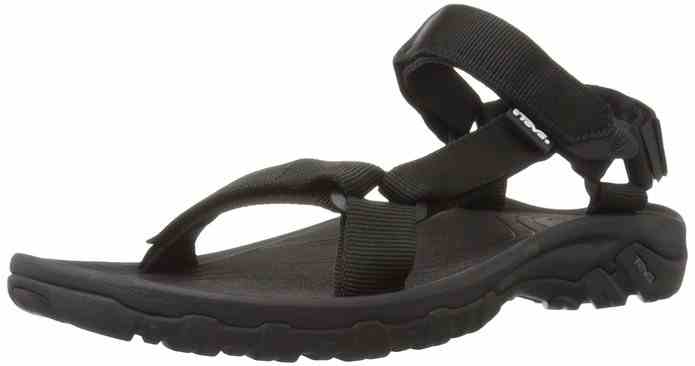Teva Sport Sandals

Comfortable, durable, healthy, versatile sandals
I can’t believe Teva Sandals haven’t been recommended here yet. I have worn various models of Teva sandals for 25 years.
Advantages:
– They are comfortable. The straps do not chafe, but are plenty durable. The velcro fastening allows quick adjustments, even if your feet swell, and even if you wear socks. They also have soft, cushy but resilient midsoles, with varying degrees of arch support.
– They are durable. For me, they last at least five summers of near-continuous wear. I replace them when the tread wears away in spots, though I don’t really need to. I have never worn the soles through to the midsoles. The straps never wear out, though the velcro eventually loses some of its grip. The velcro would be easy to replace, but I have never done it.
– They are healthy. With your feet mostly open to the air, you do not develop athlete’s foot or other fungal infections. You do not develop calluses or blisters. (You may develop a “Teva tan” however, where the straps leave a characteristic pattern on your feet.)
– They are versatile. Originally developed for rafting, they are secure, protective and grippy enough for all sorts of sports. I have played volleyball, gone hiking in Colorado’s Sangre de Cristo mountains, and toured Greece in mine. They are unaffected by water and dry quickly on your feet. With socks, they are wearable in surprisingly cold days. (The soles are all non-marking, incidentally.) You can wear them on more occasions than you might other sandals, to the ultimate benefit of your feet.
– With the Microban zinc treatment, the stinky Teva problem is gone. The sandals are stink-free, and stay that way for the life of the sandals.
– They are reasonably priced, $50 to $100, though often available for cheaper.
– There is a huge variety of models, including leather versions, flip flops, slides, models that enclose your foot to varying degrees, etc. There is even a sheepskin-lined version. But the Original Universal model is the cheapest and works great. The Hudson, Hurricane, Katavi and Terra Fi models have more aggressive soles, plus Microban, nylon shanks, and midsoles with more arch support. I prefer models without leather like the Hurricane, because leather absorbs water and dirt, darkens and stains with use and generally shows its wear, while the synthetic materials look new for years.
Disadvantages:
– They might be too casual for some settings. But that also depends on what else you are wearing. I used to wear them with khakis and button-down shirts to work in a tall office building all the time.
– I suppose there has to be one part that wears out faster than the rest. For Teva’s, it is the velcro. But it would be easy to replace the velcro, not even an evening’s work with needle and thread.
– I think there are no other disadvantages. They aren’t suited to climbing K2, working in building demolition, or attending a funeral, but you knew that already.
There are other sport sandals, notably Chaco’s and Keen’s. Chaco’s are great if their footbed fits your foot (for me they don’t.) They are notably thicker and heavier than Tevas, and more expensive. Keen’s are also great (I wear their shoes and boots all winter), but they are more elaborate, heavier and expensive than Tevas, though there is overlap. I wear Keen sandals for riding my bike, and Tevas for everything else. If I had to choose a current model, I might go for the Hurricane. It has Microban, a nylon shank, a nice molded midsole and footbed, and their more durable sole, but no leather, and it costs only $60. Their higher-end Terra-fi is much the same, but with a stickier but less durable outsole. And for the record, it is pronounced “teh-vah,” not “tee-vah.” It is the Hebrew word for nature.
12/2/16Teva Men's Hurricane XLT Sandal ($25 - $100)






